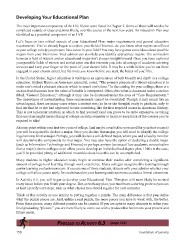Page 162 - Foundations of Learning, 4th Edition (Revised)
P. 162
Developing Your Educational Plan
The most important components of the Life Vision were listed in Chapter 2. Some of these will need to be
completed outside of class and, most likely, over the course of the next few years. An Education Plan was
identified as a potential component of an LVP.
Let’s focus on two critical aspects of your Educational Plan: major requirements and general education
requirements. You’ve already begun to explore your field of interest...do you know what majors are offered
at your college to help you prepare for a career in your field? You may have gotten some ideas about possible
majors from your interviews. Your advisor can also help you identify appropriate majors. The connection
between a field of interest and an educational major isn’t always straightforward. Once you have explored
your possible fields of interest and settled upon one that interests you, take advantage of academic advising
services and keep your finger on the pulse of your chosen field. It may be a while before you’re out there
engaged in your chosen career, but the more you know before you start, the better off you’ll be.
In the United States, higher education is built upon an appreciation of both breadth and depth in a college
education. Sydney Harris, an American journalist, noted, “The primary purpose of a liberal education is to
make one’s mind a pleasant place in which to spend one’s time.” In the catalog for your college, there is a
section that discusses how the value of breadth is interpreted. Often, this value is discussed under a section
titled, “General Education,” although it may also be discussed under the area of “Core Requirements.”
The importance of understanding these requirements cannot be overstated. Though it may sound like an
urban legend, there are many cases where a student was (so he or she thought) ready to graduate, only to
find out that he or she had neglected to take something like the first required course in American History.
This is not a pleasant situation in which to find yourself (and can prove to be quite expensive, as taking
that one class might mean staying at college an extra semester or term) so keep track of the courses you’re
required to take!
At some point within your first two years of college (and maybe even before you enroll for your first courses)
you will be required to declare a major. Once you declare that major, you will need to identify the college
requirements for that major. Perhaps, you will declare a self-defined major, where you and a faculty member
will determine the components for that major. You may also have the option of declaring a double major
(such as Information Technology and Finance) or perhaps a minor (an area of less academic concentration
than a major). Some colleges even allow you to develop an individualized degree plan. If this is the case,
you’ll be provided plenty of additional materials about how this can be accomplished.
Many students in higher education today begin or continue their studies after completing a significant
amount of college-level learning through work experience. Many colleges recognize this learning through
a prior learning evaluation process. If you are one of those students, discuss with your advisor whether your
college will allow you to apply for credit based on your learning and experience outside a formal classroom.
In Activity 6.3, you will begin to develop your Educational Plan. This plan will most likely be revised
many times before you finish your degree. But, as with any plan, you must have a starting point so you can
at least identify next steps, such as what classes you should register for next semester.
Think of this activity as one similar to putting together a puzzle. The main difference is that you define
what the puzzle pieces are. And, unlike a real puzzle, the more pieces you have to work with, the better.
From these pieces, many different puzzles can be created. If you are open to many attempts to refine your
final graduating “picture,” you are more likely to come out with a product that best meets your present and
future needs.
PROCEED TO ACTIVITY 6.3 (page 169)
156 Foundations of Learning

